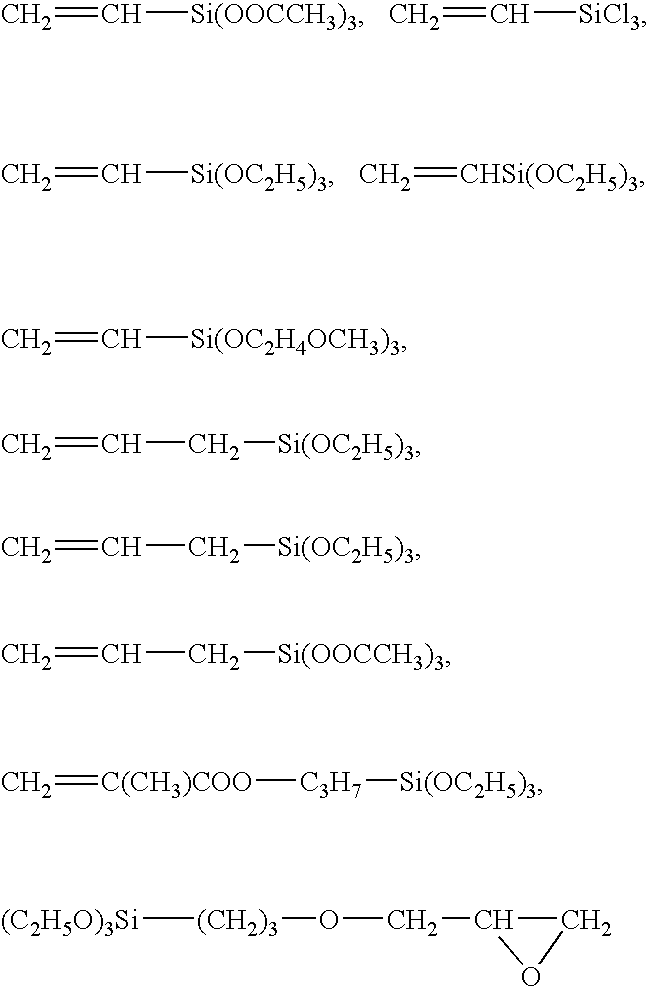Consolidated proppants having high mechanical strength and process for the preparation thereof
- Summary
- Abstract
- Description
- Claims
- Application Information
AI Technical Summary
Benefits of technology
Problems solved by technology
Method used
Image
Examples
example 1
Consolidating Agent with Organic Crosslinking Agent MPMTTi0.1-DEGDMA / AIBN
[0096]8.92 g of MTEOS, 39.05 g of TEOS, 156.51 g of methacryloyloxypropyltrimethoxysilane and 0.246 g of titanium tetraisopropoxide were mixed and were reacted with 48.07 g of demineralised water and 1.25 ml of concentrated hydrochloric acid (37%) with vigorous stirring. After the transition point, the reaction mixture exceeded a temperature maximum of 57° C. After the reaction mixture had cooled to 25° C., a mixture which consists of 96.1 g of diethylene glycol dimethacrylate and 0.235 g of 2,2′-azobisisobutyronitrile (AIBN) was added to the reaction mixture and stirring was continued for a further 5 minutes. The binder was then used for consolidating proppants under hydrothermal conditions at 70° C. and 70 bar. After injection in the displacement experiment, strengths up to 5.9 MPa result.
example 2
Consolidating Agent with Organic Crosslinking Agent MTMPTi0.1-DEGDMA / AIBN
[0097]63.85 g of MTEOS, 30.83 g of TEOS, 31.29 g of methacryloyloxypropyltrimethoxysilane and 0.179 g of titanium tetraisopropoxide were mixed and were reacted with 19.39 g of demineralised water and 3.19 g of TiOSO4 / H2SO4 with vigorous stirring. After the transition point, the reaction mixture exceeded a temperature maximum of 68° C. After the reaction mixture had cooled to 25° C., a mixture which consists of 50.45 g of diethylene glycol dimethacrylate and 0.823 of 2,2′-azobisisobutyronitrile (AIBN) was added to the reaction mixture and stirring was continued for a further 5 minutes. The binder was then used for consolidating proppants under hydrothermal conditions at 70° C. and 70 bar. After injection in the displacement experiment, strengths up to 2.0 MPa result.
example 3
Consolidating Agent with Organic Crosslinking Agent MTMP-VTi0.1-TEGDMA-BisGMA / Trigonox 121
[0098]63.85 g of MTEOS, 30.83 g of TEOS, 28.16 g of methacryloyloxypropyltrimethoxysilane, 2.40 g of vinyltriethoxysilane and 0.18 g of titanium tetraisopropoxide were mixed and were reacted with 19.39 g of demineralised water and 3.19 g of TiOSO4 / H2SO4 with vigorous stirring. After the transition point the reaction mixture exceeded a temperature maximum of 68° C. After the reaction mixture had cooled to 25° C., a mixture which consists of 47.7 g of triethylene glycol dimethacrylate, 21.35 g of ethoxylated bisphenol A glycidyl dimethacrylate (Ebecryl® 150) and 1.154 g of tert-amylperoxy-2-ethylhexanoate (Trigonox 121) was added to the reaction mixture and stirring was continued for a further 5 minutes. The binder is then used for consolidating proppants under hydrothermal conditions at 70° C. and 70 bar. After injection in the dispersant experiment, strengths up to 2.1 MPa result.
PUM
 Login to View More
Login to View More Abstract
Description
Claims
Application Information
 Login to View More
Login to View More - R&D
- Intellectual Property
- Life Sciences
- Materials
- Tech Scout
- Unparalleled Data Quality
- Higher Quality Content
- 60% Fewer Hallucinations
Browse by: Latest US Patents, China's latest patents, Technical Efficacy Thesaurus, Application Domain, Technology Topic, Popular Technical Reports.
© 2025 PatSnap. All rights reserved.Legal|Privacy policy|Modern Slavery Act Transparency Statement|Sitemap|About US| Contact US: help@patsnap.com

